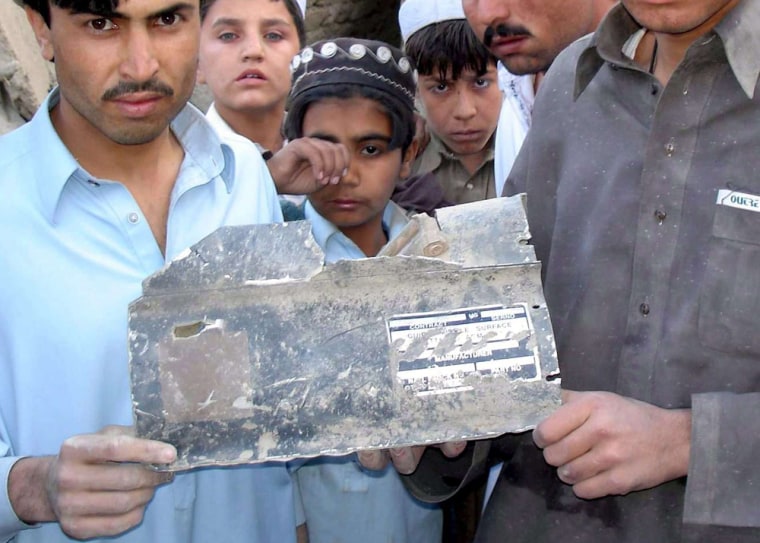Shrapnel that appeared to be from an American-made missile was found Sunday at the house where Pakistan said a top al-Qaida operative was killed in an explosion, although President Bush’s national security adviser declined to confirm the death.
U.S. and Pakistani officials declined to confirm an NBC report, citing anonymous officials, that the attack on the house where Hamza Rabia reportedly died was launched by a U.S. drone.
But local residents found at least two pieces of shrapnel at the blast scene inscribed with the designation of the Hellfire missile, which is carried by the U.S. Air Force’s unmanned, remote-controlled Predator aircraft.
The metal pieces bore the designator “AGM-114,” the words “guided missile” and the initials “US.”
John Pike, director of the defense Web site GlobalSecurity.org, said the Hellfire is used almost exclusively by the U.S. military. Al-Qaida operatives would be unlikely to have Hellfire missiles, Pike said, although he said the possibility could not be completely discounted.
‘A good thing for the war on terror’
U.S. national security adviser Stephen Hadley declined to confirm that Rabia, said to be among al-Qaida’s top five leaders and responsible for planning overseas attacks, was dead or that the attack was carried out by a pilotless U.S. plane.
“At this point we are not in a position publicly to confirm that he is dead. But if he is, that is a good thing for the war on terror,” Hadley told “Fox News Sunday.”
Rabia was involved in planning two assassination plots against Pakistani President Gen. Pervez Musharraf, and “we believe he was involved in planning for attacks against the United States,” Hadley said.
Musharraf said Saturday it was “200 percent confirmed” that Rabia was killed.
The senior Pakistani intelligence official said the missile attack blew up a stockpile of bomb-making materials, grenades and other munitions. Pakistan Interior Minister Aftab Khan Sherpao said Rabia’s two Syrian bodyguards also died in the explosion.
'A big blow for them'
Sources told NBC that Rabia was one of five men killed at a safehouse located in the village of Asorai, in western Pakistan, near the town of Mirali.
Information Minister Sheikh Rashid Ahmed declined to comment on the report about Rabia’s remains but said there was “other information” besides the DNA tests that confirmed his identity.
“He was a high-profile commander in the network. We were tracing him for the last two years,” Sherpao told The Associated Press on Sunday. “Naturally any person killed in their hierarchy is a big blow for them.”
An intelligence official said U.S. help was involved in tracking Rabia down and “eliminating the threat” that he embodied. That official spoke on condition of anonymity because he is not authorized to speak to the media.
Local residents said that the men were killed by an unknown number of missiles fired by an unmanned Predator aircraft. The witnesses said they had heard six explosions, but it is uncertain how many of these were the result of missile attacks and how many may have been the result of the missiles detonating explosives inside the safehouse.
On Saturday, Pakistan’s Dawn newspaper, citing sources it did not identify, reported that the attack on a mud-walled home near Miran Shah may have been launched from two pilotless planes.
Associates from outside Pakistan retrieved the bodies of Rabia and two other foreigners and buried them in an unknown location, the report said.
Rabia had moved up al-Qaida ranks
Two U.S. counterterrorism officials, who spoke on condition of anonymity because of the information’s sensitivity, said Saturday that Rabia was believed to be an Egyptian and head of al-Qaida’s foreign operations, possibly as senior as the No. 3 in the terrorist group, just below al-Qaida leader Osama bin Laden and his lieutenant, Ayman al-Zawahri. They are believed to be hiding in a rugged area along Afghanistan’s border with Pakistan.
Rabia’s death would not enhance the prospect of catching either bin Laden or al-Zawahri, according to another Pakistani intelligence official, who requested anonymity because of the sensitive nature of his job. The official said intelligence agents had no clue about the whereabouts of bin Laden or al-Zawahri.
Rabia filled the vacuum created this year by the capture of the previous operations chief, Abu Faraj al-Libbi, the two U.S. officials said.
Rabia would have been responsible for training, recruiting, networking and, most importantly, planning international terrorist activities outside the Afghan-Pakistan region. He had a wide array of jihadist contacts, one official said, and was believed to be trying to reinvigorate al-Qaida’s operations.
One Pakistani intelligence official said Rabia had been the target of a Nov. 5 attack in the same area that killed eight people, but he managed to escape. That attack initially was blamed on militants setting off bombs they were making.
Miran Shah is a strategic tribal region where al-Qaida militants are believed to be hiding and where Pakistani forces have launched several operations against them.
